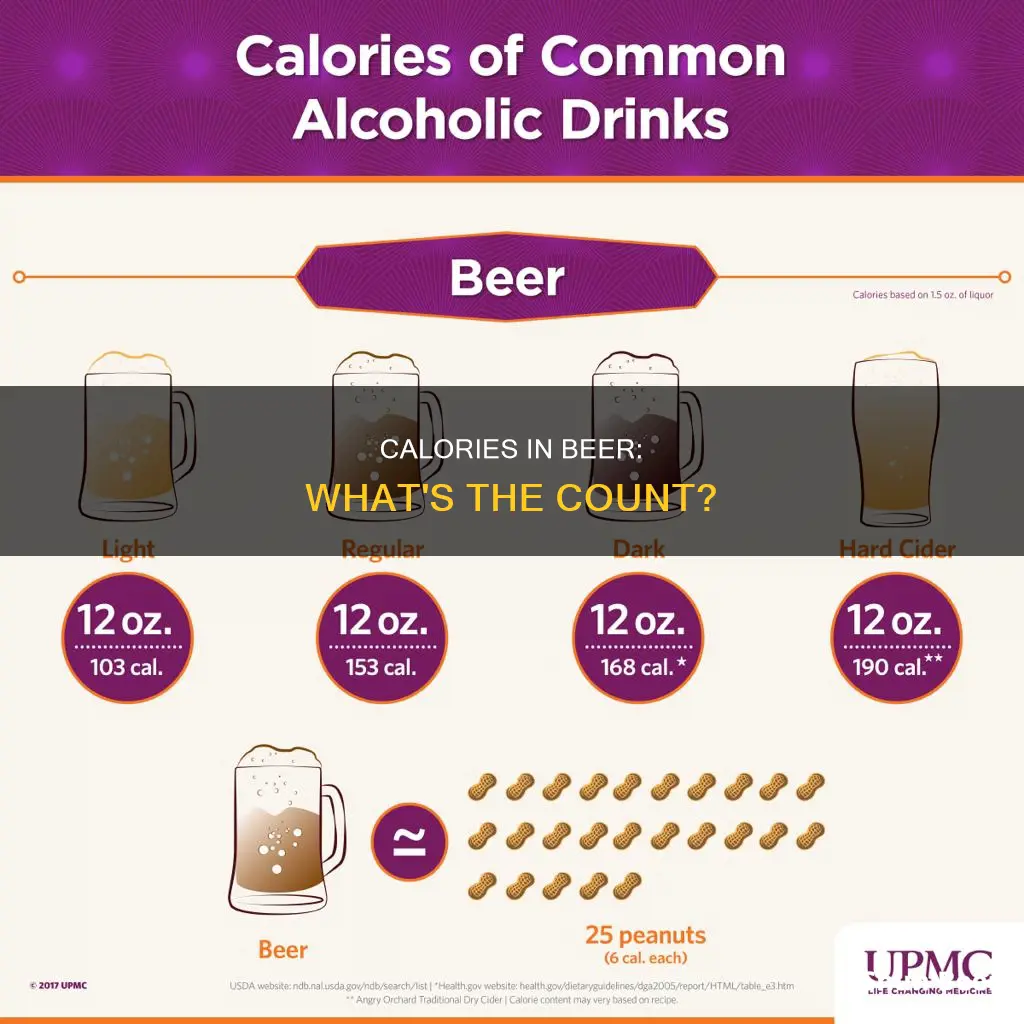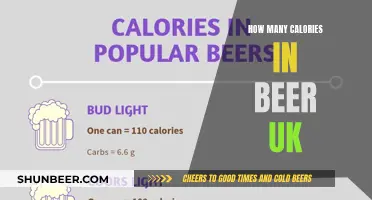
Beer is a popular drink worldwide, but it's important to be aware of its calorie content, especially if you're watching your weight. The calorie count in beer varies depending on the type and maker, but on average, a 12-ounce beer has around 150 calories. The calorie content is influenced primarily by the alcohol content, with higher ABV beers tending to have more calories. Light beers, on the other hand, typically have fewer calories due to their lower alcohol content, ranging from 50 to 100 calories per 12-ounce serving. Additionally, craft, seasonal, and high-alcohol content beers tend to have more calories than lighter options.
What You'll Learn

Calories in beer range from 50 to 300+ depending on the type
Beer is made from fermented grain, and the calories in beer come mainly from carbs and alcohol. The number of calories in beer varies depending on the type and maker. Typically, beer contains around 150 calories, but this can range from 50 to 300 or more. Light beers tend to have fewer calories, ranging from 50 to 100 calories per 12-ounce serving. The alcohol content is the main factor influencing the calorie count, with light beers containing less alcohol and therefore fewer calories.
The ABV (alcohol by volume) of a beer is a good indicator of its calorie content. A simple formula to calculate the calories in a beer is ABV% x 2.5 x ounces of beer. For example, a 16-ounce beer with 6% ABV would have around 240 calories. The higher the ABV, the more calories the beer will have. A lager with 4.5% ABV in a 12-ounce serving will have around 135 calories, while a barrel-aged stout with 10.5% ABV in the same serving size will have about 315 calories.
Some specific examples of popular beers and their calorie content include Bud Light with 110 calories, Budweiser with 145 calories, Coors Light with 102 calories, and Corona Extra with 148 calories. Heineken, another popular import, has approximately 149 calories per 12-ounce bottle. Michelob Ultra, a favourite among dads, has only 95 calories, making it one of the lowest-calorie options on the market.
When it comes to health considerations, it's important to note that the recommended daily limit is two alcoholic beverages or fewer for men and one alcoholic beverage or fewer for women. This guideline helps protect the liver and heart. Non-alcoholic and light beers are good options for those watching their calorie intake, as they typically contain fewer calories. Additionally, drinking water between alcoholic beverages and using pre-measured cups can help moderate consumption.
Beck's Blue Beer: Calorie Count for Health-Conscious Drinkers
You may want to see also

Alcohol content is the main factor influencing calorie count
The calories in beer are mostly influenced by its alcohol content. The higher the alcohol content, the more calories the beer will contain. This is because alcohol contains calories; each gram of alcohol contains around seven calories. Therefore, a beer with 5% alcohol by volume (ABV) will have fewer calories than a beer with 8% ABV. For example, a 12-ounce serving of a 5% ABV beer will contain around 150 calories, while a 12-ounce serving of an 8% ABV beer will contain about 200 calories.
The alcohol content of a beer is determined by several factors, including the amount of fermentable sugars in the wort, the type and amount of malt used, and the brewing process. Beers with a higher percentage of malt or with malt that has a higher percentage of fermentable sugars will have a higher alcohol content and, consequently, more calories.
Additionally, residual sugars, which are the sugars that remain in the beer after fermentation, can also impact the calorie content. Beers with more residual sugars will have a higher calorie count, even if their alcohol content is the same as a beer with fewer residual sugars. This is because sugars also contain calories, with each gram of sugar containing approximately four calories.
The type of beer can also make a difference. For instance, light beers are designed to be lower in calories and carbohydrates, typically having around 100 calories per 12-ounce serving. On the other hand, IPAs and other craft beers can be heavy hitters, packing 200 to 300 calories in a 12-ounce serving.
However, it is important to note that while alcohol content is the main factor influencing calorie count, it is not the only factor. The presence of residual sugars, the type and amount of malt used, and the overall brewing process can also impact the number of calories in a beer.
Calorie Counting: Beer Edition
You may want to see also

Light beers have fewer calories
Beer is not exactly a nutritional powerhouse, but that doesn't stop us from drinking it! If you're watching your weight, however, it's good to know that light beers have fewer calories.
The number of calories in beer varies depending on the beer and the maker. Typically, a beer will have around 150 calories, while a light beer will have between 50 and 100 calories per 12-ounce serving. The calories in beer come from alcohol and carbohydrates (starches and sugars from unfermented grains). Light beers have fewer calories because they contain less alcohol.
The Dietary Guidelines for Americans recommend up to one serving of alcohol per day for women and up to two servings per day for men. A serving is defined as 12 ounces of beer that is 5% alcohol by volume (ABV). Most domestic beers contain about this amount of ABV. If you're looking for a low-carb beer, look for wording that indicates "light" or "calories under 120."
Some examples of light beers with fewer calories include:
- Budweiser Select 55: 55 calories, 1.9 grams of carbs, 2.4% ABV
- Coors Light: 102 calories, 5 grams of carbs, 4-5% ABV
- Miller Lite: 96 calories, 3.2 grams of carbs, 4.2% ABV
- Amstel Light: 95 calories, 5 grams of carbs, 3.5% ABV
- Corona Premier: 90 calories, 2.6 grams of carbs, 4% ABV
- Michelob Ultra Pure Gold: 85 calories, 2.5 grams of carbs, 3.8% ABV
So, if you're watching your weight, opting for a light beer can be a good way to go. Just remember to drink in moderation and be mindful of the overall carbohydrate content and added sugars in flavored varieties.
Cherry Wheat Beer: Calorie Count and Nutrition Facts
You may want to see also

A standard 12-ounce beer has around 95-150 calories
The number of calories in a beer varies depending on the type of beer and its maker. A standard 12-ounce beer typically contains around 95 to 150 calories. Light beers tend to have fewer calories, ranging from 50 to 100 calories per 12-ounce serving. The calorie content in beer is influenced primarily by its alcohol content, with higher ABV beers generally having more calories. For example, a lager with 4.5% ABV and 12 oz. will have approximately 135 calories, while a 12 oz. barrel-aged stout with 10.5% ABV will have about 315 calories.
The calories in beer come from two main sources: alcohol and carbohydrates, specifically starches and sugars from unfermented grains. Beer is not known for its nutritional benefits, but it can be enjoyed in moderation as part of a healthy diet. Dietary guidelines recommend no more than one serving per day for women and two servings per day for men, with a serving defined as 12 ounces of beer with 5% alcohol by volume (ABV).
To make smarter choices when ordering beer, individuals can opt for light beers, non-alcoholic beers, or pay attention to the beer nutrition facts to select options with lower alcohol content. Additionally, drinking water between alcoholic beverages and using pre-measured cups can help moderate intake.
Calorie Counting: Bud Lite Beer's Nutritional Breakdown
You may want to see also

Beer has more calories than wine or spirits
Beer is a much-loved beverage, but it's important to be aware of its calorie content. Calories in beers vary depending on the maker and the type of beer. Generally, beer contains about 150 calories, but this can range from 50 to 300 calories for a 12-ounce serving. The calorie content is influenced primarily by the alcohol content, with light beers having fewer calories.
When compared to wine or spirits, beer does tend to have a higher calorie count. A pint of 5% ABV beer contains around 240 calories, according to the NHS, while a 175ml glass of 12% ABV wine contains approximately 133 calories. This difference can be attributed to the leftover carbohydrates found in beer, as wine typically has a lower sugar content.
The higher calorie content of beer means that it can contribute to weight gain over time. While a single pint may not have a significant impact, drinking 5 pints of lager each week adds up to 44,200kcal over a year, equivalent to consuming 221 doughnuts! This is in stark contrast to the commonly held belief that beer leads to weight gain only in the short term.
However, it's important to note that the relationship between alcohol consumption and weight gain is complex. A review of studies found that neither wine nor beer drinkers tend to gain weight in the short term, with the longest study lasting only 10 weeks. Additionally, individual drinks within the categories of beer and wine can vary, with some beers having lower calorie counts than certain wines.
If you're looking to reduce your calorie intake without giving up alcohol completely, spirits such as vodka, gin, tequila, or a glass of champagne are good options, as they tend to be lower in calories.
Presidente Beer: Calorie Count and Health Considerations
You may want to see also
Frequently asked questions
The number of calories in a beer depends on the alcohol content and the amount of carbohydrates. A 12-ounce beer with 5% ABV typically contains around 150 calories. Light beers have fewer calories, ranging from 50 to 100 calories.
A typical 12-ounce beer has a similar number of calories to a can of Coke, which is around 140 calories. Beer tends to have more calories than wine or spirits like whiskey.
Yes, opting for low-calorie or non-alcoholic beers can help reduce your calorie intake. Drinking water between alcoholic beverages and using pre-measured cups to monitor portion sizes are also effective strategies.







